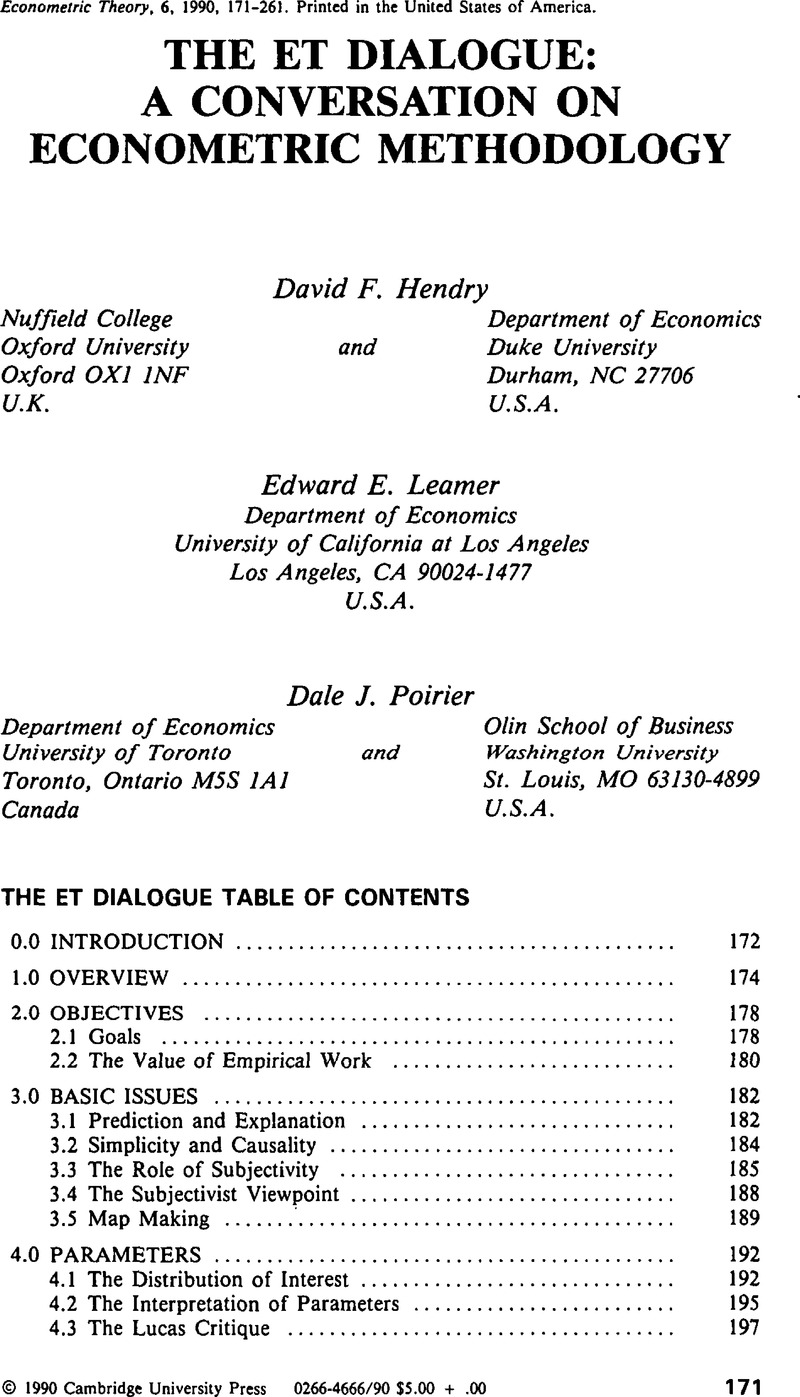Crossref Citations
This article has been cited by the following publications. This list is generated based on data provided by Crossref.
Poirier, Dale J.
1991.
The Limits of Econometrics by Adrian C. Darnell and J. Lynne Evans, Edward Elgar Publishing Limited, 1990.
Econometric Theory,
Vol. 7,
Issue. 3,
p.
409.
1991.
THE STRUCTURE OF ECONOMETRIC ANALYSIS.
Journal of Economic Surveys,
Vol. 5,
Issue. 2,
p.
199.
Poirier, Dale J.
1991.
Editor's introduction.
Journal of Econometrics,
Vol. 49,
Issue. 1-2,
p.
1.
Gunawardana, P. J.
and
Oczkowski, E. A.
1992.
GOVERNMENT POLICIES AND AGRICULTURAL SUPPLY RESPONSE: PADDY IN SRI LANKA.
Journal of Agricultural Economics,
Vol. 43,
Issue. 2,
p.
231.
Thompson, Grahame F.
1993.
Causality in economics: Rhetorical ethic or positivist empiric?.
Quality & Quantity,
Vol. 27,
Issue. 1,
p.
47.
1993.
ON THE HISTORY AND METHODOLOGY OF ECONOMETRICS.
Journal of Economic Surveys,
Vol. 7,
Issue. 1,
p.
85.
Redman, Deborah A.
1994.
Karl Popper’s Theory of Science and Econometrics: The Rise and Decline of Social Engineering.
Journal of Economic Issues,
Vol. 28,
Issue. 1,
p.
67.
Oxley, L.T.
1995.
An expert systems approach to econometric modelling.
Mathematics and Computers in Simulation,
Vol. 39,
Issue. 3-4,
p.
379.
Keuzenkamp, Hugo A.
1995.
THE ECONOMETRICS OF THE HOLY GRAIL — A REVIEW OFECONOMETRICS: ALCHEMY OR SCIENCE? ESSAYS IN ECONOMETRIC METHODOLOGY.
Journal of Economic Surveys,
Vol. 9,
Issue. 2,
p.
233.
Mirowski, Philip
1995.
Three ways to think about testing in econometrics.
Journal of Econometrics,
Vol. 67,
Issue. 1,
p.
25.
QIN, Duo
1996.
BAYESIAN ECONOMETRICS: The First Twenty Years.
Econometric Theory,
Vol. 12,
Issue. 3,
p.
500.
Hendry, David F.
1997.
On congruent econometric relations.
Carnegie-Rochester Conference Series on Public Policy,
Vol. 47,
Issue. ,
p.
163.
Cuthbertson, Keith
1997.
Microfoundations and the Demand for Money.
The Economic Journal,
Vol. 107,
Issue. 443,
p.
1186.
Cook, Steven
1999.
Methodological aspects of the encompassing principle.
Journal of Economic Methodology,
Vol. 6,
Issue. 1,
p.
61.
Yonay, Yuval
2000.
An Ethnographer’s Credo: Methodological Reflections Following an Anthropological Journey among the Econ.
Journal of Economic Issues,
Vol. 34,
Issue. 2,
p.
341.
Antoch, Jaromir
and
Hanousek, Jan
2000.
Model Selection and Simplification Using Lattices.
SSRN Electronic Journal,
Boylan, Thomas A.
and
O’Gorman, Paschal F.
2001.
Editorial.
Revue internationale de philosophie,
Vol. n° 217,
Issue. 3,
p.
303.
Antoch, Jaromir
and
Hanousek, Jan
2001.
Model Selection and Simplification Using Lattices.
SSRN Electronic Journal,
Hendry, David F
2001.
Achievements and challenges in econometric methodology.
Journal of Econometrics,
Vol. 100,
Issue. 1,
p.
7.
Hoover, Kevin D.
and
Perez, Stephen J.
2001.
Truth and Robustness in Cross-country Growth Regressions.
SSRN Electronic Journal,



